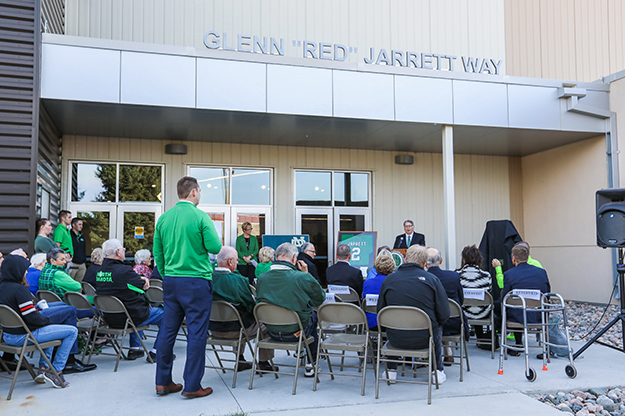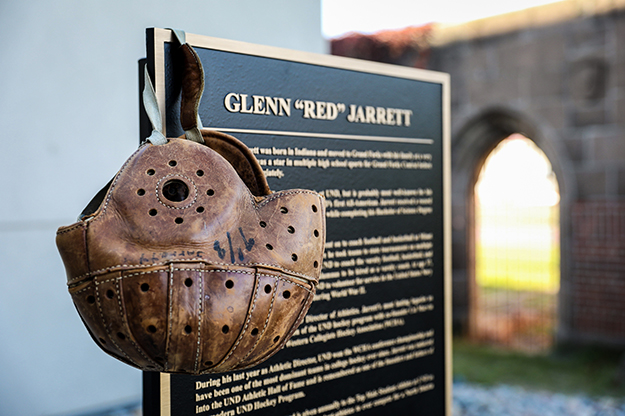Green at heart but ‘Red’ is the ‘Way’
UND dedicates entrance of High Performance Center in honor of one of school’s pioneering great athletes

UND’s first All-American athlete was one of Grand Forks’ own.
On a beautiful Friday morning, the Alumni Association & Foundation dedicated Glenn “Red” Jarrett Way at the UND Athletics High Performance Center in his honor. The title adorns the awning above the facility’s west entrance.
As a student athlete, coach and athletic director, the late Glenn “Red” Jarrett represents everything remarkable about UND Athletics.
“I often times say that we stand on the shoulders of giants,” University President Mark Kennedy remarked to a gathering of administrators, alumni, friends and family members.
He marveled at the dedication and passion detailed in Jarrett’s history as an athlete and leader. One of his many accomplishments was the establishment of UND’s modern hockey program and, in turn, the Western Collegiate Hockey Association (WCHA).
“Red Jarrett made no small plans,” Kennedy said. “And because he made no small plans, he put North Dakota on a trajectory to be the university we love and cherish today.”
All-around all-star
Born Oct. 23, 1907, in Ligonier, Ind., Glenn Leroy Jarrett moved to the Grand Forks area as a young boy, where he earned the nickname, “Red,” for the color of his hair.
Jarrett attended Grand Forks Central High School, where he excelled in football, basketball and track and field, helping the school earn multiple state championships. From there, he enrolled at UND in 1927.
Jarrett competed in the same three sports from 1928 to 1931. He started at forward on the basketball team and halfback on the football team, where he drew national attention.
In 1930, UND went up against West Point’s Army team — a squad that hadn’t given up a touchdown all season. Jarrett changed that, as he ran one in from 32 yards out. However, in the end, Army, would hand UND their only loss that season.
Coverage of the Army matchup and Jarrett’s performance earned him the first selection to an All-American football team in UND’s history. It also earned him another nickname: “Red Rabbit.”
UND Football’s Head Coach Kyle “Bubba” Schweigert and Athletic Director Brian Faison also spoke of Jarrett’s lasting impact.
“It’s awesome — to be the first one to pave the way for UND Football — to get on that train, head out to Army and be the only person that scored against them,” said Schweigert. “It’s just awesome that our first All-American grew up here… Jarrett’s such a rich part of the tradition of UND Football.”
“Army was Alabama,” Faison said. “That’s how good Army and Navy were in those days; it was a truly remarkable situation. I think it really set the table for the program to start taking the next step in football. As an athlete, Jarrett was ahead of his time in a lot of ways.”

Career in athletics
Jarrett lettered nine times, three in each sport in which he participated, and graduated in 1931 with a bachelor’s degree in physical education. Desiring a position as a high school football coach, he headed to Minot. He remained there until 1938, when his former college coach, Charles “Jack” West, wanted Jarrett as his assistant on the football staff. He was the first alumnus hired to coach a varsity team at UND.
This launched a 20-year career as a coach. He eventually took head coaching roles in football, basketball and track and field. He became UND’s athletic director, upon West’s departure, in 1946.
Perhaps Jarrett’s crowning achievement as a UND Athletics leaders came from a sport he never played or coached.
In 1947, at the behest of student and hockey standout Cal Marvin, Jarrett set UND Hockey on a course from a club level to the D-I powerhouse of today. While Marvin gathered a roster, Jarrett worked with other directors to produce the framework for what’s now the WCHA (UND has since moved to the National Collegiate Hockey Conference).
By the time Jarrett retired in 1958 due to illness, UND had won the conference championship and was well on its way to national prominence. Today, the program has eight NCAA championships.
Jarrett passed away April 26, 1962.

Honoring Red
In addition to tributes from University administrators, Jarrett’s grandson, also named Glenn, spoke on behalf of three generations of Jarretts in attendance. He thanked everyone for their hospitality and a special weekend of UND sports in honor of Red.
He also presented his grandfather’s leather football cap and jump rope — now important relics in UND history.
In addition to the lettering above the entrance, Jarrett’s son, Dr. John Jarrett, and grandson Glenn unveiled a plaque, greeting those who enter the High Performance Center. The plaque offers a glimpse at the rich history of a UND legend.
“This is called what it’s called for a reason,” Faison said, in reference to Jarrett’s dedication. “Because Glenn “Red” Jarrett had a way. So it’s not just about this being the way to the High Performance Center, but for all of our athletes, coaches, support staff and community, there is a way. It’s that competition; it’s that focus; it’s that discipline; it’s that passion.”



